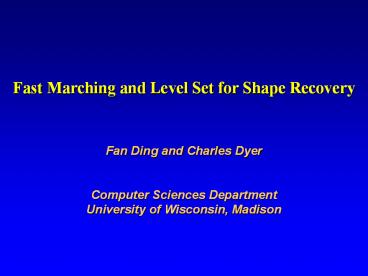Fast Marching and Level Set for Shape Recovery PowerPoint PPT Presentation
Title: Fast Marching and Level Set for Shape Recovery
1
Fast Marching and Level Set for Shape Recovery
- Fan Ding and Charles Dyer
- Computer Sciences Department
- University of Wisconsin, Madison
2
Motivation CS766 course project
3
Level Set Methods
- Contour evolution method due to J. Sethian and
S. Osher, 1988 - www.math.berkeley.edu/sethian/level_set.html
- Difficulties with snake-type methods
- Hard to keep track of contour if it
self-intersects during its evolution - Hard to deal with changes in topology
4
- The level set approach
- Define problem in 1 higher dimension
- Define level set function z ?(x,y,t0)
- where the (x,y) plane contains the contour, and
- z signed Euclidean distance transform value
(negative means inside closed contour, positive
means outside contour)
5
How to Move the Contour?
- Move the level set function, ?(x,y,t), so that
it rises, falls, expands, etc. - Contour cross section at z 0
6
Level Set Surface
- The zero level set (in blue) at one point in
time as a slice of the level set surface (in red)
7
Level Set Surface
- Later in time the level set surface (red) has
moved and the new zero level set (blue) defines
the new contour
8
Level Set Surface
9
How to Move the Level Set Surface?
- Define a velocity field, F, that specifies how
contour points move in time - Based on application-specific physics such as
time, position, normal, curvature, image gradient
magnitude - Build an initial value for the level set
function, ?(x,y,t0), based on the initial
contour position - Adjust ? over time current contour defined by
?(x(t), y(t), t) 0
10
Speed Function
11
Example Shape Simplification
- F 1 0.1? where ? is the curvature at each
contour point
12
Example Segmentation
- Digital Subtraction Angiogram
- F based on image gradient and contour curvature
13
Example (cont.)
- Initial contour specified manually
14
More Examples
15
More Examples
16
More Examples
17
Fast Marching Method
- J. Sethian, 1996
- Special case that assumes the velocity field, F,
never changes sign. That is, contour is either
always expanding or always shrinking - Can convert problem to a stationary formulation
on a discrete grid where the contour is
guaranteed to cross each grid point at most once
18
Fast Marching Method
- Compute T(x,y) time at which the contour
crosses grid point (x,y) - At any height, T, the surface gives the set of
points reached at time T
19
Fast Marching Method
(i)
(ii)
(iii)
(iv)
20
Fast Marching Algorithm
- Construct the arrival time surface T(x,y)
incrementally - Build the initial contour
- Incrementally add on to the existing surface the
part that corresponds to the contour moving with
speed F - Builds level set surface by scaffolding the
surface patches farther and farther away from the
initial contour
21
Fast Marching Visualization
22
Fast marching and Level Set for shape recovery
- First use fast marching to obtain rough contour
- Then use level set to fine tune with a few
iterations, result from fast marching as initial
contour
23
Result segmentation using Fast marching
No level set tuning
24
Results vein segmentation
No level set tuning With
level set tuning
25
Results vein segmentation continued
Original
Our result Sethians
result
(Fast marching
(Level set only)
Level set
tuning)
26
Result segmentation using Fast marching
No level set tuning
27
Results brain segmentation continued
No level set tuning With
level set tuning
28
Results brain image segmentation
of iterations 9000
of iterations 12000 Fast marching only, no
level set tuning
29
Result segmentation using Fast marching
No level set tuning
30
Result segmentation using Fast marching
With level set tuning

